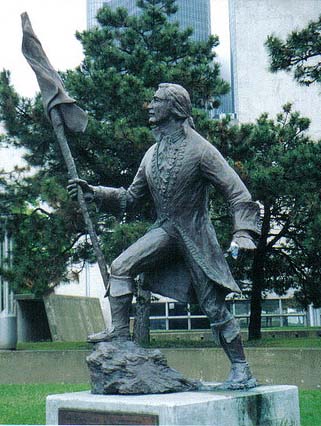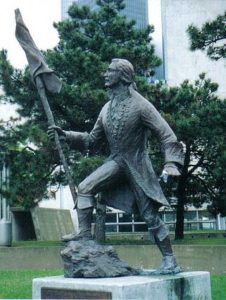Antoine de la Mothe, Sieur de Cadillac
Antoine de La Mothe, Sieur de Cadillac served as the governor of Louisiana from 1713 to 1716.

Courtesy of Flickr
Statue of Antoine de la Mothe, Sieur de Cadillac. Femaletrumpet02 (photographer)
Although he is best known as the founder of Detroit, Michigan, Antoine de la Mothe, Sieur de Cadillac, served as the fourth colonial governor of Louisiana from 1713 to 1716. A native of France, Cadillac was critical of the moral shortcomings he perceived among Louisiana’s inhabitants, yet his penchant for self-promotion and dubious schemes called into question his own character. Although his term of office in Louisiana was notable for the establishment of important settlements at Natchitoches, Natchez (in present-day Mississippi), and elsewhere, an ongoing feud with his predecessor, early Louisiana leader Jean-Baptiste Le Moyne, Sieur de Bienville, overshadowed his tenure.
Born Antoine Laumet in St. Nicolas-de-la-Grave, France, in 1658, he adopted the name Cadillac and a false lineage of French nobility as a young soldier and adventurer. He left France for the New World in 1683, embarking on a career as a merchant sailor—and possibly a buccaneer. After impressing the superintendent of the French fleet with his knowledge of the North American coast, Cadillac won appointment as commander of French marines in the country’s North American colonies in 1690; in 1694 he was named commander of French forts in the Upper Great Lakes. He founded Fort Pontchartrain du Detroit in 1701; a few years later, he was accused of illegal trade in furs and alcohol from that strategic outpost and was briefly imprisoned in Montreal.
King Louis XIV appointed Cadillac governor of Louisiana in 1710, but he first returned to France and spent two years attempting to recruit investors for enterprises in the territory. He induced Antoine Crozat, a wealthy and influential French financier, to assume commercial oversight of the region, in which the government of France was losing interest. Arriving in Louisiana in 1713, Cadillac explored the Mississippi Valley, started a lead mining operation in Missouri, over enthusiastically touted the region’s potential mineral wealth to officials back in France, and sought unsuccessfully to establish mines in Mexico. Crozat—largely displeased with Cadillac’s administration, the return on his own investments, and the governor’s disputes with Bienville and others—campaigned for Cadillac’s removal. After being recalled to France in 1716, Cadillac was imprisoned in the Bastille for four months, but he eventually cleared his name and purchased for himself the governorship of Castel-Sarrasin, France, where he died in 1722.
All but forgotten in Louisiana, Cadillac is honored with a statue in downtown Detroit; his name and a family crest that he confected were appropriated by the founders of the Cadillac auto company in 1902. He also is the namesake of Cadillac Mountain, located in Acadia National Park, Maine, where he once lived; at 1,528 feet, it is the tallest peak along the East Coast of the United States.
